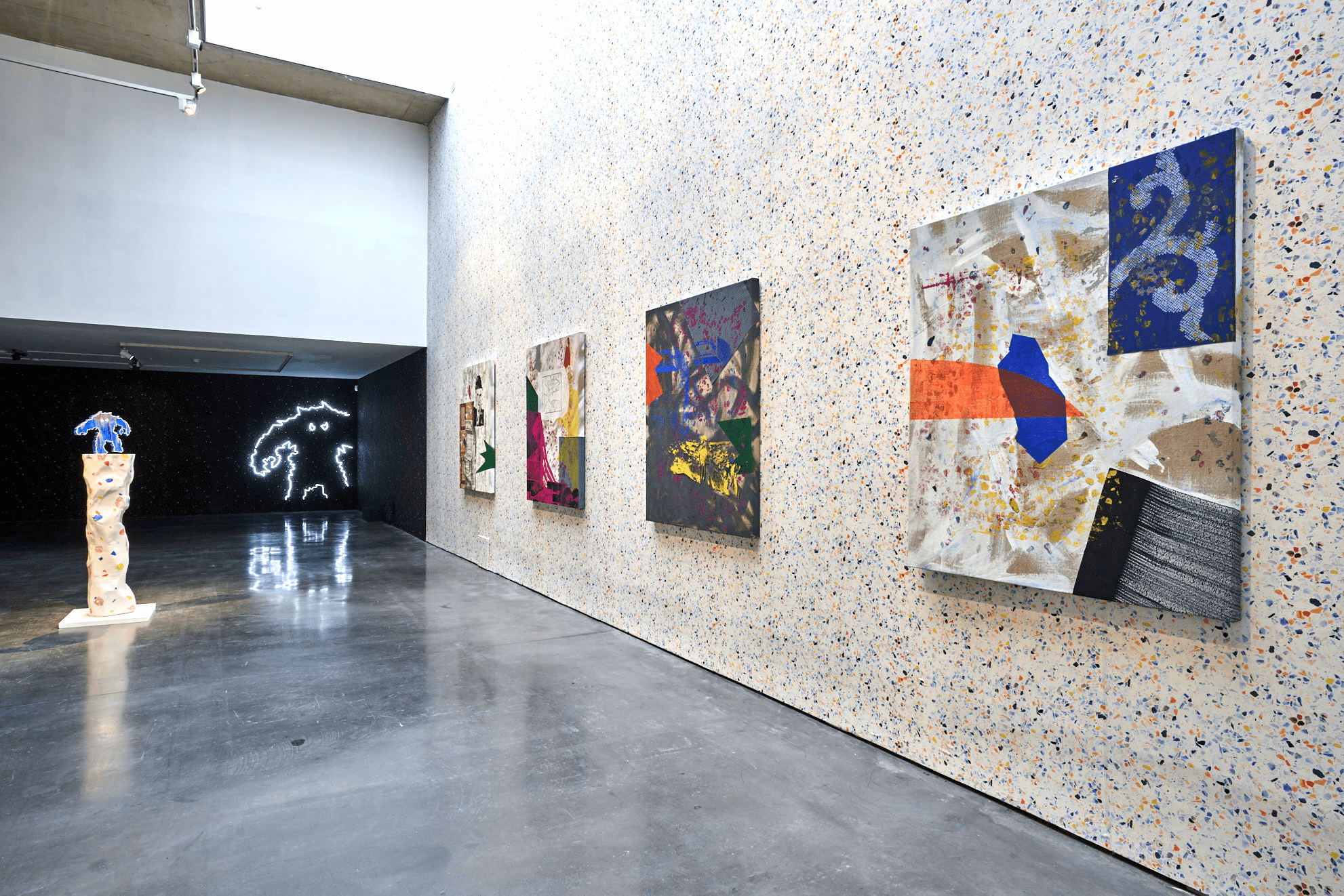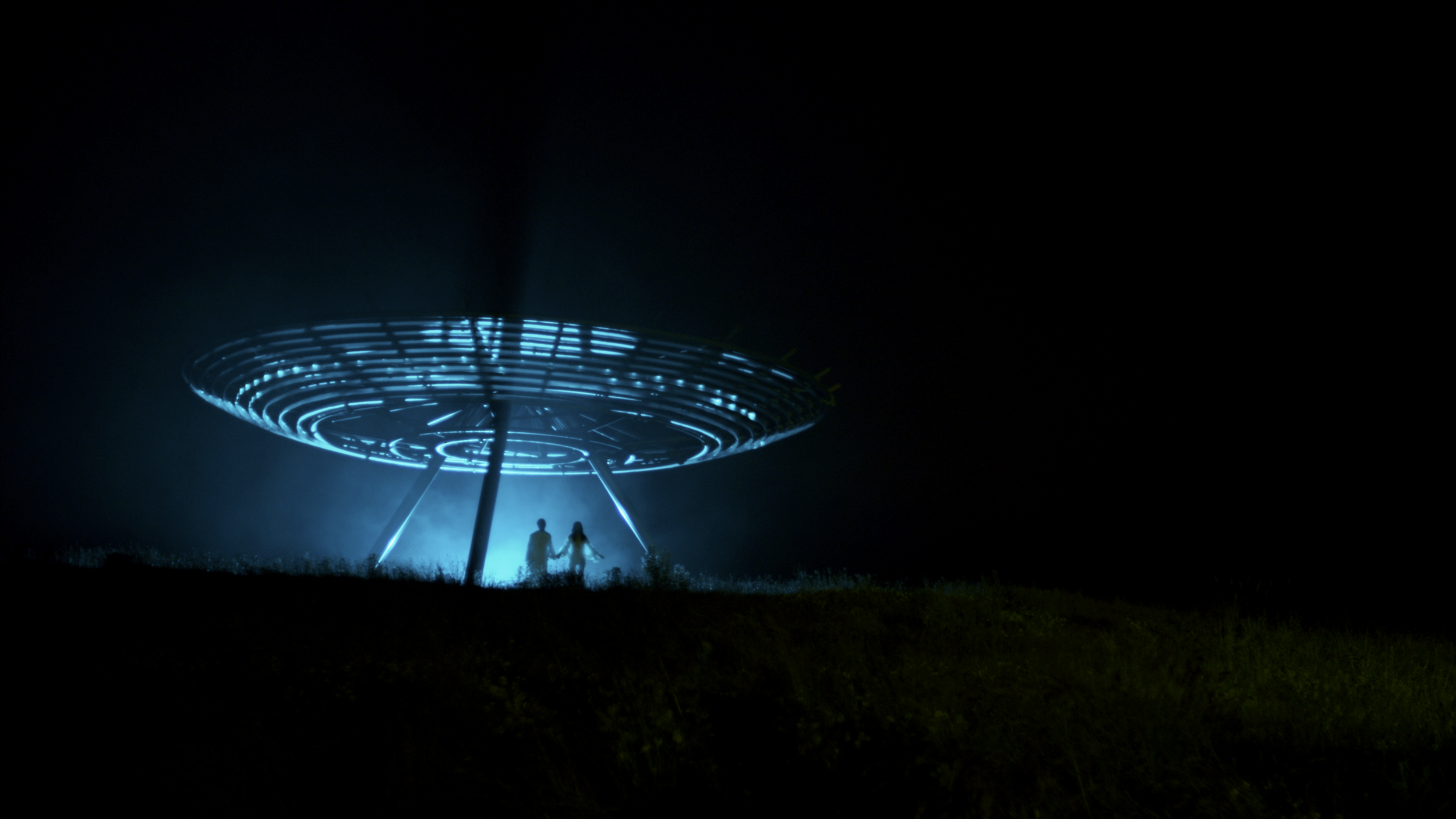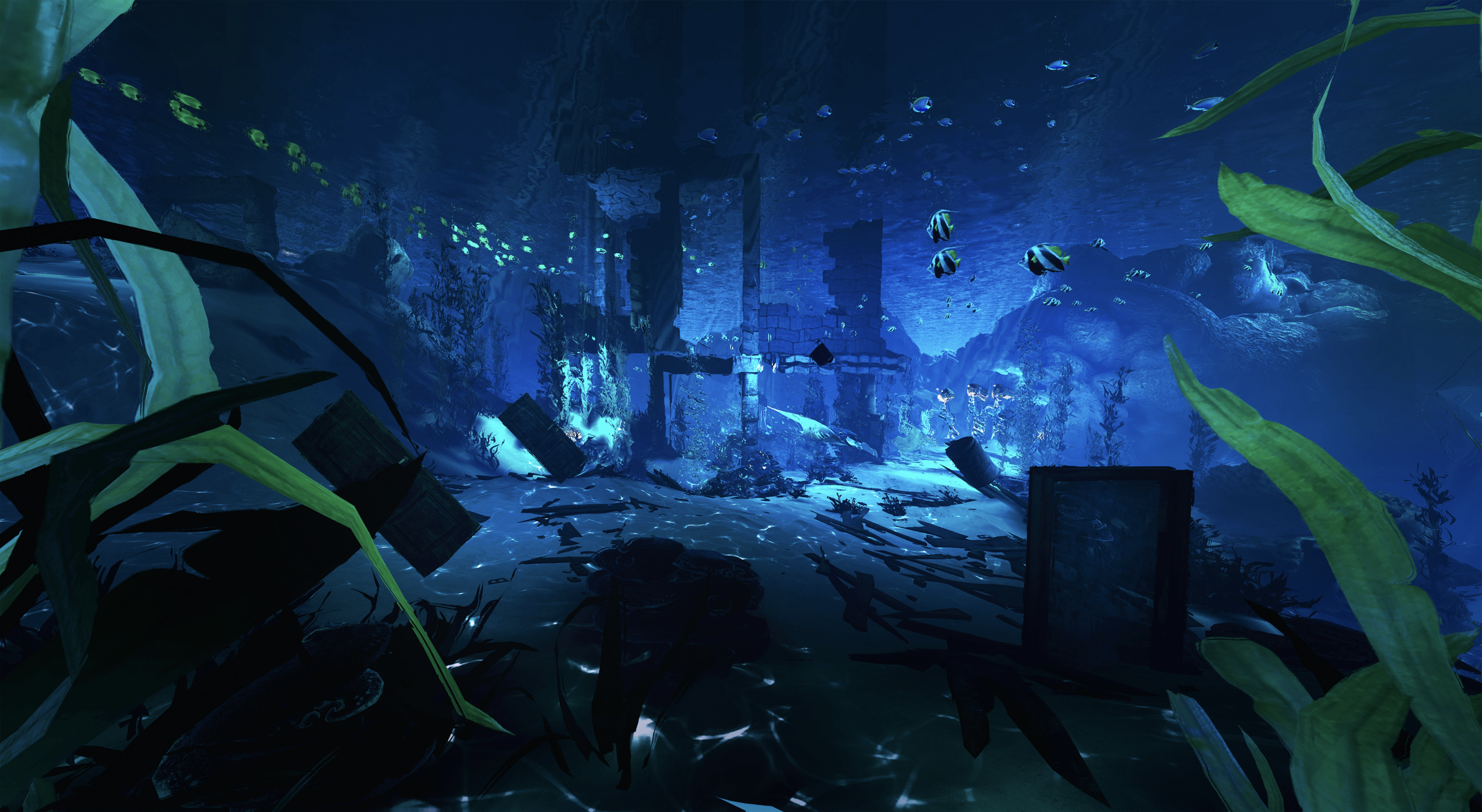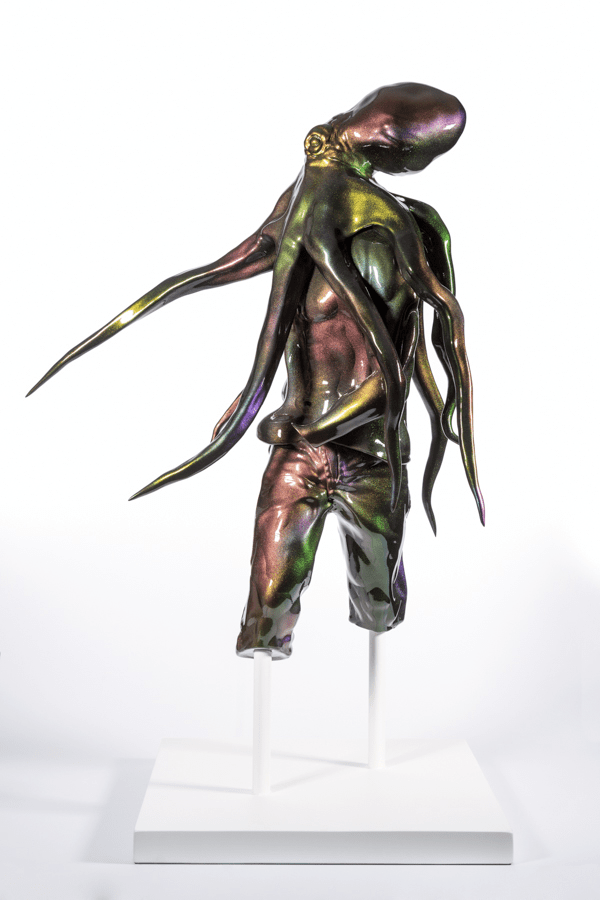Creating Realities — In Conversation with artist Shezad Dawood
Shezad Dawood's exhibition Encroachments at the New Art Exchange in Nottingham was one of the last shows I saw before the first national lockdown. I recently caught up with Shezad to discuss all things VR, multimedia and materiality, as well as his recent VR works, 'Leviathan' and 'The Terrarium'.
Encroachments, New Art Exchange, Nottingham, 18 January - 15 March 2020. Courtesy of New Art Exchange, photography by Reece Straw.
Shezad Dawood works across painting, film, virtual reality, performance, neon, sculpture, and digital media to create richly layered artworks that interweave and interrogate narratives, histories, realities and symbolism. His fascination with the esoteric, otherness, the environment and architectures both material and virtual can be seen across numerous projects, most recently at WIELS, Brussels and Manifesta 13, and previously at institutions as varied as The Bluecoat, Tate Britain, MoMA, MOCA Toronto and the MORI Art Museum, Tokyo; and at the Gwangju, Taipei, Sharjah and Venice Biennales.
Could you tell me more about how each medium affects your artistic process?
Encroachments, production still, 2019, VR environment, duration variable. Co-commissioned by Sharjah Art Foundation - SB14, 2019 and New Art Exchange, Nottingham. Generously supported by the Bagri Foundation. Courtesy of the artist, Jhaveri Contemporary, Mumbai and Timothy Taylor, London
There are probably ten different ways I could answer this question. From the onset, even when completing my MA, I didn’t want my practice to be limited by the ecology around me. I saw artists who were, either for economic reasons or because of cultural frameworks, forced to repeat the same gesture. This was over 20 years ago and it’s interesting to see how things have changed – now, you see more and more practices being enacted through different media.
I collaborate a lot in my work, as you do when you are making film. So this idea of collaboration and thinking across media and practices was almost an organic part of what I did. I think maybe there's something of an immigrant tendency to mix media and methodologies. I've never been embarrassed of being an immigrant. I wear it as a as a badge of pride because I think that's where new knowledge comes from. If you look through history, it's polyglot states that always generate a huge step forward. And then the conservative factions around them can't handle it, like what's happening in London currently.
For me, digital and physical media are fully interlinked. If I'm thinking spatially, I'm editing. Whether it's cutting up the fabrics that make up my textile paintings, or whether I’m cutting up either literally an analogue film or metaphorically in digital film. You're always thinking through space, you're thinking through image, symbol, time, duration, fragments, echoes, and it’s as much present in painting as it is in filmmaking. Moreover, all media overlap, as they all question our notion of reality. A performance can been as a sort of overlay onto reality, almost a Photoshop projection. But then so is our architecture and our shopping centres.
Piercing Brightness, 2013, 75 minutes, HD and Super 16mm transferred to HD. Courtesy of UBIK Productions.
Where does each of your works start or stop?
The different media need each other. Without working across media, I have the impression of not fully doing my job, with regards to the audience. You can either sit back or you can invite the audience with you, ask them to have a chat, 'go for a walk together through the work'. It’s about creating open systems, where people come out with their own conclusions. A non-didactic framework.
Would you say that the invitation to a conversation is an immaterial aspect that binds the works together? Using materiality to create immateriality?
Yes, exactly. As much as objects can be entrancing in themselves, it is also about paying equal attention to the conversation and space between them, whether real or virtual.
How did you get into working with virtual reality?
A friend of mine, who is a coder, would just tease me. He was basically the guy who got me looking at VR and without our friendship and relationship, I don’t think I would have. I owe a lot to that. He managed to get me an HTC Vive 3 or 4 years before they went public, which gave me this lucky opportunity to incubate something ahead of others. I was on the fence, but it was very useful to sit around with a headset for three years before anyone else.
To me, it’s important to not make VR into a gimmick, there needs to be a reason for working with VR. My first VR work was in 2016 and gradually it became a very natural extension of my attempts to make immersive cinema and work with the dynamic ordering of sound. This is very much how I make paintings, I think about them as a dynamic editing in space with layers that move backward, and reorient your programming to the 'real' and therefore allow you to question the sign-symbol connection, and what it does in terms of an affect and creating a feeling of parallax.
Leviathan Legacy: Part. 1, 2018, Virtual Reality Environment, Duration variable. Courtesy of UBIK Productions.
On the idea of exploring space and reality – when I think of VR, it makes me rethink the way I think about making art in general. Is there a difference in the way you approach making a work in VR versus a physical one?
Rather than changing my thinking, working with VR confirmed and helped progress my thinking. I have always been obsessed, maybe to my own detriment, with the philosophical idea of the immateriality of everything. Adding the VR element to my practice, helped me to re-incite my interest in physical objects, as they took on new meanings in relation to VR. Paradoxically, VR was giving me a reason, again, to make physical objects.
How do you feel about VR as a space as a ‘non-space’. Is it only alive when inhabited by a human?
Any non-space reveals or poses the very problematic question of whether you are entering it from an equal non-space? Philosophically, you are in the Schrödinger’s cat situation. That becomes a very interesting way to think about, not just the space of VR, but the space of 'reality'. I don't really believe in reality, for me, it's about posing a question about dividing lines.
I went to a very interesting UFO conference back in circa 2010 as part of my research for ‘Piercing Brightness’, which is a science-fiction feature film set in the northwest of England, in Preston. The work is in multiple languages, as seen through multiple characters’ eyes, and it’s questioning this idea of ‘real experiences’. How do we attempt to frame the fragmentation of the real that's been going on for centuries, for example in terms of narrative subjectivity, so that each character is experiencing their own reality?
Do you feel like having access to multiple cultures has reinforced your realisation of difference in perceptions?
I think if you're grounded in one language or cultural system, in a more absolute way, reality is much more potent. And if, for whatever reasons, you are migrant, then you are fleeting, you're ephemeral, you're less bound to the ideological purity of any one system. And therefore, you can start to see systemically. So yes, you start to realise that there's a degree of relativism in everything. And obviously, you need to avoid the trap of getting totally sucked into a relativism where you can't act. It does open up certain possibilities. Even thinking of the language of code, next to English, or Urdu that I grew up with, suddenly they all become languages or systems, and you don't have to be entirely wedded to any one of them.
The more ideologically bound you are to a nation or language or system, I think, the more frightened you are of change, of systemic alteration. But it's going to happen regardless, and, for me, the best way of not getting caught up in rabbit holes of fear, dread or apathy, is to think and act in the spaces between systems, methods, moments. And there are these beautiful things that appear in these spaces.
Leviathan Legacy: Part. 1, 2018, Virtual Reality Environment, Duration variable. Courtesy of UBIK Productions.
Tell me more about the Leviathan cycle and your decision to create your first VR work in this series? How does it connect to your most recent VR work Terrarium?
Leviathan is a ten-part film cycle based on current scientific research in human and marine ecologies. It speculates on an imminent future – so many predictions that were supposed to happen in 10, 20, 30 years have been accelerating.
I premiered the first Leviathan film at the Venice Bienniale in 2017 and a friend of mine seeded the idea of using VR. At first I was skeptical, but my lightbulb moment was to jump further into the future, a full 150 years from now onto a beach in Cuba and the Gulf of Mexico, which is the location on Earth with the most Future casting research in terms of reef systems. This was possible thanks to Prof Madeleine van Oppen’s future coral research and Dr Louise Firth’s work on mitigation of coastal erosion. I realised that the more you look into scientific research, the more you learn that everything is structurally connected. Coral plays an important role, not solely in terms of immediate biodiversity and reef ecosystems, but also as a barrier against tsunamis and tidal waves. They are a major buffer against coastal erosion. As humans, we tend to be so averse to complexity and it’s our biggest blind spot. I am trying to comprehend it, approach it as ‘environmental intersectionality’. It’s vital that we find better ways of understanding and communicating these nuances. There is interconnectedness and it requires structural overhauls to secure the continuation of our species.
The Terrarium, 2020, VR, duration variable, (featuring parts of Anthropocene Island TAB17 by ecoLogicStudio and excerpts from Shifter by Graham Fitkin), commissioned for Kai Art Center and Creative Folkestone Triennial 2021 by UP Projects and is supported by Tallinn Culture Department and CUPIDO, a project co-funded by the European Union and Arts Council England. Courtesy of UBIK Productions.
Maybe there is a need to accept that reality is multiple and have a framework that can adapt to this multiplicity?
Here we are stumbling towards quantum theory, which has been an integral part of my spiritual practice and active thinking. Quantum theory is interestingly rooted in non-Western thinking. The idea of planes existing side by side, of us being multidimensional beings. There is amazing research happening and Leviathan has been all about making this research visible and translatable to the general public. This also requires editing and taking the texts out of their formal narration into a more accessible language.
On Becoming Virtual Octopi, 2018, Resin and polychromatic paint, 104.3 x 72.3 x 49.8 cm. Courtesy of the artist and Timothy Taylor, London.
To go back to Terrarium, which is the VR sequel of Leviathan and takes place 300 years in the future. This time it looks at what could happen in the geographical space between Kent and Talinn. A major influence was Dr Martin Ziegler’s research. He is a paleoclimatologist at the University of Utrecht, whose research includes speculative mapping that simulates the future of Europe, from millions of years in the past into the future. In that reality, the English coastline has eroded significantly – Norfolk, a fair amount of Suffolk, Kent Essex, were all gone. Equally, because the Netherlands, Denmark and Sweden were under water, there was a continuous body of water to the Baltic. Coincidentally, I was approached by the Folkestone Triennial, that was supposed to take place in 2020 (but was pushed back to 2021) and I was also working with the Kai Art Center in Talinn, which allowed me to bring this research to life.
Terrarium not only imagines this future water world, but it also speculates on human mutations. In 2019, I was interviewing DNA scientist Prof Eske Willerslev and I remember shocking the audience by asking him questions about subjects such as splicing human DNA with octopi or other species, for both our adaptability and also fashion. His response was that this is entirely possible, and whilst this might seem freakish to us, the same might have been said about plastic surgery 70 years ago. At what point could we splice our DNA with an octopus to be able to change colour?
This is a very powerful image.
I made a 3D printed sculpture, ‘On Becoming Virtual Octopi’ and it is imagining an octopi-human hybrid being, based on Terence McKenna’s theories. McKenna speculated that we had reached the threshold of simian evolution and the next step for humans was cephalopod consciousness, which is octopus, squid and their prismatic vision. He thought that this could be reached through some kind of psychedelic consciousness. Thinking about his theories in convergence with Donna Haraway’s ideas on post-human evolution, I was interested in empathy and our lack of it towards other species. Could we change it by becoming infected by other species’ DNA? Whilst this might seem far away from reality, this is also what I felt about the Leviathan episode that I wrote in 2018 (which was screened at Manifesta last year), focusing on global pandemics scientists predicted would take place in 10-15 years. And the reality was that people watching it in Marseille were already undergoing it as a reality. Reality and fiction were collapsing into each other.
Shezad Dawood’s latest VR work, The Terrarium, will have its UK premiere at Folkestone Triennial 2021.
Words: Polina Chizhova





